I stumbled across an article recently that told of a potential new psychiatric disorder, orthorexia nervosa, an unhealthy obsession with healthy eating. Or to put it in more blunt (Al-like) terms, being too fucking neurotic over what one eats. Now, I’m among the first to believe the psychiatric professions can be over-exuberant in describing and diagnosing new disorders – the fields do not, and can not, produce the inarguable results and unmistakeable evidence that empirical fields such as archaeology can – and what even constitutes a ‘disorder’ is an area without delineations, all shades of grey. But I don’t really have a hard time believing this one, since I see the key elements of it on an almost-daily basis; this is especially telling since I’m a trimmed beard away from being a hermit. Now, I don’t expect nor encourage anyone to take my word on anything here – in fact, I will state this right up front: go look this shit up for yourself. Get informed. But the functional part of this is seeking real info in the first place, not assuming that your knowledge is already complete, nor that your preferred sources of info are necessarily accurate. What I hope to do here is introduce some perspective to illustrate why this is even necessary.
A little background. My first job out of school was in a natural food store, one that my folks eventually purchased and ran for a while (though I quickly moved on to other things myself.) I had direct immersion into various aspects of the healthy food ‘experience,’ and plenty of contact with pretty much the entire spectrum of behavior and outlooks. And while I earlier credited a youth bible camp as fostering a lot of my current emphasis on critical-thinking, the time spent with people focused on, and downright obsessed with, the idea of healthy eating also bears a lot of the credit for my skepticism; the vast majority of information freely distributed in such circles ranges from misunderstanding of published scientific results to complete and utter fucking bullshit.
I can’t put all of the blame on the healthfood mavens, however, because a large part of it also stems from the human tendency to go overboard, as well as the ridiculous reliance on fads and trends. Two specific, timely examples: sugar and gluten.
Not long ago I found an article from a dietician who lamented that processed sugar is not a toxin, in any way, and he was extremely tired of having to repeat that. I could identify, because I’ve been reminding (or outright informing) people of this for decades. Processed sugar is almost entirely glucose and sucrose, which our bodies routinely use for their energy needs; they are, in point of fact, absolutely necessary for us to live, and processed sugar is among the most efficient ways of introducing these into the body, since the body needs expend virtually no effort in refining these molecules for introduction into the useful parts of the system. Sugar is not especially bad for the teeth; most of the enamel-destroying acids comes from starches, actually. And sugar is not especially fattening. Drinking a soda made with sugar will not automatically add fat to your system. The difficulty – the only difficulty – with processed sugar is that we like it, and can easily seek out foods with a lot of it. If we eat these foods to excess (key words here,) then we may put on more weight than is ideal. That’s it.
The ability to interpret those words correctly and without hyperbole is what mankind is rather inept at. Bare truth: taking the sugar out of soft drinks does not make them any healthier, or any less dangerous to us, by more than a tiny fraction, since they have so few dietary benefits in the first place. There are studies indicating that sugar substitutes actually produce worse effects on our system than the sugars would have. The primary thing to take away from this is very simple: don’t eat anything to excess, because there is no key ingredient that makes anything healthy or unhealthy.
I’ll use that cue to sidetrack slightly, and address the idea of toxins. While it’s not quite safe to say that toxins don’t exist – biologists use the word to describe elements that some species produce specifically to inflict on other species, in either defense or obtaining food – the idea that any substance we might encounter (outside of insects or reptiles) is toxic is, well, completely misunderstood. An article in National Geographic a few years back explained it quite simply: toxicity is not a matter of substance, but of dosage. Everything can be toxic if we receive enough of it – even water, even oxygen. But the dosages, and even the chemical bonds formed in certain circumstances, dictate how bad, or good, the effect on us is. Both chlorine and sodium are pretty nasty substances; exposure to either in concentrated and unaltered form can kill us very quickly. But sodium chloride, otherwise known as table salt, is actually necessary for the functioning of our bodies. Excessive salt (mostly sodium) can lead to various reactions such as hypertension, which in the long run increases our chances of heart issues, and very excessive amounts will clog the kidneys and lead to death very quickly, which is why drinking seawater is bad. But there’s no way to consider either chlorine or sodium a “toxin” because they’re both necessary for our continued health.
And so we come back to gluten. Gluten is just a pair of proteins found in cereal grains – “true gluten” being found only in wheat, while similar protein combinations can be found in other grains. During bread formation, gluten binds the dough together in an elastic way, allowing for the stretching, Silly-Putty-like consistency of dough and the even distribution of small pockets of CO2, the by-product of yeast that makes all those little holes in bread. Without gluten, the CO2 production forms a big bubble in the dough, which tears easily and collapses, so producing rising bread without gluten is tricky. It is not a toxin, by any stretch, and the only hazard to gluten is if you have a specific intolerance, such as an allergy, to it. That’s it. There’s nothing else. No study has ever found an inherent problem with gluten within human systems overall, nor even very serious adverse effects. Extreme reactions can happen with severe allergies, but most people who even exhibit the intolerance get the horrifying health issue of an upset tummy from it. If you’ve eaten bread all your life without issue, feel free to continue to do so, despite the plethora of products and food preparers trumpeting their remarkable “gluten-free” properties.
This really is an important aspect of it all, though, and deserves a lot of attention. The majority of people don’t read studies. The majority of people don’t even look up “gluten” when they go on a gluten-free diet, much less get advised to do so by someone qualified, like a doctor or dietician. They hear the hype, they see the grocery stores carrying more and more products advertising their lack of gluten, and think, “Holy shit, if everyone is reacting to it, it must be really fucking bad for me!” And this is the drastic misunderstanding of hype and marketing that occurs constantly, because of course the more people who think (I feel bad using that word here) in this way, the more the food producers are going to jump on the bandwagon and heave out products that pander to knee-jerk consumerism. No federal source has mandated a reduction in gluten for any reason whatsoever; no study has determined that a reduction in gluten has any effect on our lifespans. The rising number of allergies (to lots of substances) which sparked a few companies producing gluten-free alternatives for pretzel-lovers snowballed, through blind consumerism, into this pathetically ignorant fad. Seriously, don’t believe me – I readily admit it sounds stupid, and not something that our technological species should have succumbed to – and look it up for yourself.
I have to insert a vital point in here, sparked by my attempts to find an article mentioned previously. Online research requires a little discretion, and the ability to spot when someone is vomiting up utter bullshit. Simple rule: if it’s in popular media, especially if it’s a YouTube video, accuracy is completely up for grabs, but likely drops below even a 50/50 chance. Actual scientific papers, the ones where people have to show their work and then it gets vetted by a large number of other people experienced within the field, is about as trustworthy as we can get – and even that has some issues. However, if your work is utter shit, you’ll never get published in scientific journals – but you can make a video or send some press release to whatever media outlet likes sensationalist stories, and never have to worry about whether facts are involved or not. And this happens quite frequently. If in doubt about your media source, do a search within on stories about UFOs or Bigfoot; a positive hit tells you accuracy and solid info is not their forté…
There is (at the very least here in the states, but I suspect throughout Europe as well) a strong emphasis on ‘healthy eating,’ which is a topic that’s as widely variable as it is hard to define – that right there is a significant clue. Once again, it has a lot to do with not understanding what recommendations really are, but owes no small credit to fear-mongering and blatant exaggeration (see above.) To begin with, let’s step back and examine what the goal is to eating healthy in the first place. Extended lifespan, and not dying young? Fair enough. The problem is, there’s no magic formula to accomplish this. First off, there are so many variables in human lives that no single element, not even a remarkably-restricted diet, is capable of accomplishing this. The healthiest diet ever presented, for whatever definition you choose to use there, cannot prevent us from getting cancer (much less being killed in an auto accident.) And the worst diet ever conceived, same criteria again, isn’t guaranteed to kill us within a few years or even decades. Health, aside from being very hard to define, relies on a ridiculous number of factors, diet being only one of them. When anyone thinks they’re quoting from a study that says that red meat, for instance, is bad for us, they’re usually not noticing that the study has found excessive consumption is correlated with increased tendencies toward a specific health issue, such as colon cancer. What this actually means is, it’s probably not a good idea to eat red meat at every meal. It does not say that red meat will give you cancer, much less that avoiding red meat will provide a cancer-free life. These distinctions might seem obvious, but it’s not hard at all to find people who have utterly failed to interpret these correctly.
Actually, it’s hard to find someone who has read the damn study in the first place – usually, they’re just parroting the interpretation of a study that they received from some source they trusted; perhaps some daytime talk show, maybe a health-food niche magazine, possibly even something their friend said. As soon as any one of them makes any of the mistakes outlined above (or any other example thereof,) then we’re no longer dealing with real information at all. Naturally, such mistakes can be made at every repetition as well, so it takes very little time for real information to become tainted, twisted, or spun out of control.
Some of that is intentional, as well. Those who gain money from their own ‘healthy’ alternative foods have plenty of reason to promote the dire consequences of not buying their product, unsurprisingly, but even those who have nothing to gain can be remarkably exaggerative. Despite the fact that our lives are longer than ever now, and so many debilitating illnesses have all but vanished, we live in a culture where danger stalks us at every turn, from fluoride in our drinking water to high-tension power cables overhead. While it is true enough that the bran and germ portions of wheat, so often removed to make smoother, better-tasting flour, are more nutritive than the white endosperm, somehow this has been taken to mean that the skins of all vegetables are more nutritious, and that “processed food” has no redeeming value. Cooking does indeed break down a few beneficial vitamins, but what’s left behind is not a totally inert substance, much less something that is actively bad for our health. This bizarre fixation on binary thinking springs up a lot – if it’s not good for us, it’s bad; if it’s not healthy food, it’s unhealthy. This is obvious nonsense, but the attitude is pathetically quite common. There is no such thing as a ‘healthy’ food, and really, no supportable ability to even plot foods on a useful graph of health. Our bodies process all foods to extract that which is useful for us and discard the rest, and we discard every day. Moreover, everyone’s system is different in subtle, and sometimes overt, ways – I personally have developed sensitivities to peanut-butter and oregano, which makes them less-than-ideal for me (mostly due to adverse affects on my digestion, and not necessarily being harmful,) but these probably have no impact on you.
We can denote statistical averages for a lot of things, including primary diets and general longevity, or instances of some kind of cancer, but these are most often only tendencies, and not translatable to ‘healthy’ or ‘unhealthy’ in a functional manner. Moreover, such statistics cannot account for the countless variables that exist that may also be skewing the numbers, which include environment, genetics, and even just random variation. But we’re not a species that likes such vague results; we want to be able to apply a useful label to things just to avoid ambiguity. The attempt to do so, however, can just as often result in a label which is completely incorrect.
To say nothing whatsoever of seeing only the facts that we want to. Any of us can seek out and find studies that support our pre-existing viewpoint, that proves us right – even though we should be trying to find things that prove us wrong, just to see if they really exist. On top of that, we are (for some reason) infatuated with victimhood; if we feel bad, if we do not have the advantages that we believe we should have, it’s not our fault if we can find some element that caused it. This appears among far more topics than simply food. But hey, if we get a virus that knocks us down for a few days, it’s not simply a random occurrence or contact with someone infectious, but the fault of the food preparers who sacrificed our health for the sake of profits. There really is this idea that, were it not for outside influences, we would be in perfect health, as if such a thing actually existed. This is complete horseshit – not just the abstract concept of perfect health, but also that we are by default healthy. There is no equilibrium to be found, no ground state of being (despite all the averages we might calculate); life is constant change, and not just ours, but the myriad forms surrounding us as well. A virus may pop up that dodges our natural immune system, and we may take a few days to overcome it – that’s just how it goes. Some days, tension or air quality or all sorts of other factors might cause us to develop a headache – this cannot be taken to mean that we have done something wrong, or that we never would have had a headache if it weren’t for those damn fluorescent lights.
We cannot ignore the “more is better” attitude either. While it is almost certainly true that exercising is better than a sedentary lifestyle, this does not mean that conditioning for a marathon makes it even better – there are no superlatives, no absolutes, to be found. And the improvements, in most cases, probably amount to only a few percentage points, again, among the countless different factors encountered throughout our lives. We would consider it ironic that we get struck by a car and killed while pursuing our health, yet this is simply a demonstration that controlling our health is only partially within our grasp. There are many, many things we cannot change, or even account for, so fixating on any collection is next to meaningless.
We can also ask, again, what the goal truly is. An extended lifespan is a distinct possibility, but why, exactly, are we extending it? Is there some kind of record to set? Is there some reward that comes when we die? If we spend our lives obsessed with the effort of extending them, what are we accomplishing? Perhaps using the time we actually have to, you know, live our lives is something to consider? And probably makes us more entertaining at parties. I’m not going to espouse the idea of justified foolhardiness, but at the same time, I cannot espouse the idea of living in constant fear of the inevitable, either. Again, this isn’t a black-or-white decision – there’s a lot of middle ground.
The extent that this grips people is sometimes astonishing, as indicated by the potential new disorder mentioned in the opening paragraph. I’ve seen enough of this myself, and it’s also easy to find with some online searching, usually without even trying. For instance, this woman appears to live in constant fear of anything that a manufacturer might do, including thinking white glue will actually poison her children through casual skin contact (her demonstration of this, using one of the more potent natural oils, is hilarious. Hey, I cry while chopping onions – that means I’m absorbing onion juices through the knife blade, right?!?!) But if we buy into all of the fear-mongering, without ever asking ourselves if it even makes sense, that’s not a healthy approach either. Stress really can affect our health, much more so than white glue, than sugar, than bread; believing that ‘toxins’ lie in wait around every corner is hardly a mellow approach.
Anecdotal evidence is rampant within such lifestyles, and in fact, just about the only thing that is trusted. There’s something amusing about this, since anecdotal evidence is only slightly more trustworthy than reading chicken entrails. Stomach bothering you? Oh, it must be because you ate high-fructose corn syrup. Here, drink this tea. Did it go away? That’s the healing power of the tea! Of course, nearly every minor stomach ailment will go away on its own within a day, but the tea will get the credit if someone wants to believe in the power of the tea. Placebos work on the human trait where we can feel better if we expect to feel better, and worse if we expect that too. And of course, any potential correlation is seized upon, whether it exists or not. A doctor told me once that most cases of “food poisoning” are anything but – the bacteria that causes it are exceedingly rare and usually cannot survive basic food preparation, much less get reintroduced at some point along the line. But we eat two to three times a day, so any virus that causes abdominal distress in any way gets linked to the last meal. In this particular case, the culprit was kinetosis anyway…
Back in that natural food store, I worked with a woman who bought all of the health fad stuff wholesale; natural fibers for clothes, no microwaved food, no pharmaceuticals, and more herbs than you can shake a stick at. Her daughter lived the same way, but her sons didn’t buy into the lifestyle at all. Her daughter died at a young age of cancer, while her sons suffered no major maladies at all. This is, of course, just as anecdotal as any other account you might find, but think about how this must strike the person dedicating all of their life to ‘healthy’ approaches. What went wrong? What little, unaccounted-for toxin snuck past the defenses? How could this have been prevented? If you really believe that we are by default healthy, then how much more paranoid can this actually make you? If you want to find something to blame, it will be found – perhaps driving past the chemical plant daily, or eating school lunches while growing up. Does this really help anything at all? Can this possibly be considered a good lifestyle?
The professional advice, the stuff that can apply to nearly everyone, has remained the same for decades: eat a balanced diet and exercise. That’s really all that’s necessary, because it counteracts the tendencies that we have not to. It’s not a high bar to reach, and serves no purpose in repeatedly being pushed higher. Just chill. Trusting those who sell hype for a living, believing that our advanced society is brimming with dangers and toxins and carcinogens, is not just irrational, it’s paranoia. Nobody needs that. And if you want to let your diet go for a day and have a little junk food, this isn’t going to affect you in any measurable way – our bodies are remarkably adaptive and hardly so fragile that a Twinkie is going to crash the system.
Coming up: A further examination of some related factors, that I split off because this was already going too long ;-)
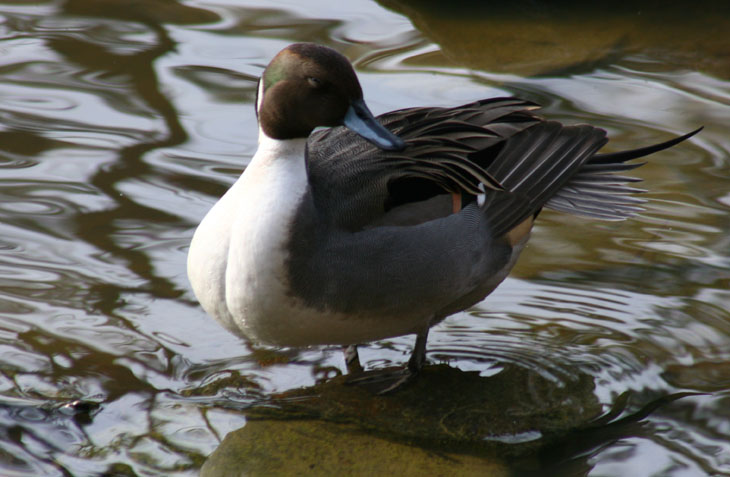
 While UNC’s Botanical Gardens are dedicated mostly to native NC plants and replicating natural habitats, this one was more decorative and landscaped. It’s all a matter of taste; I prefer the natural-looking stuff more, and actually hate most of what passes for landscaping anymore, especially the lone decorative tree in a mound of pinestraw mulch – I have no idea how that became the standard in the US, but it’s unbelievably pathetic, like using a kindergarten drawing as a decorative plan. Lest I give the wrong impression, this one was quite a bit better than that, with a pleasant layout and some real effort put into aesthetics, but it still says “artificial” too much for me. It is a favored locale for weddings and bridal shoots, but they charge a ridiculous fee just for a portrait permit, and because of this I have removed all references to them from my posts – sorry, no free advertising on this end.
While UNC’s Botanical Gardens are dedicated mostly to native NC plants and replicating natural habitats, this one was more decorative and landscaped. It’s all a matter of taste; I prefer the natural-looking stuff more, and actually hate most of what passes for landscaping anymore, especially the lone decorative tree in a mound of pinestraw mulch – I have no idea how that became the standard in the US, but it’s unbelievably pathetic, like using a kindergarten drawing as a decorative plan. Lest I give the wrong impression, this one was quite a bit better than that, with a pleasant layout and some real effort put into aesthetics, but it still says “artificial” too much for me. It is a favored locale for weddings and bridal shoots, but they charge a ridiculous fee just for a portrait permit, and because of this I have removed all references to them from my posts – sorry, no free advertising on this end.
 We’re not talking high art here, but I just wanted to point out something curious. The red in this image takes up a tiny percentage of the total area, but because it forms such a marked contrast from both its immediate surroundings and from the tones of the entire frame, it grabs attention – we notice it, but there’s no reason to look at it closely because it’s immediately apparent what it is. Since it’s there, however, it has to take a balanced place in the framing; too close to the edge, and it would seem cut off and perhaps subconsciously uncomfortable to the viewer, while putting it closer to the center implies there’s more that we should be paying attention to, without good reason. Yet without that dribble of red, the image would appear (even more) lacking in color, heavy emphasis on the grey-blue cast of overcast days – it was actually in deep shade during bright but hazy conditions, the same conditions as the weathervane pic above. It illustrates the difference between a dominant shape or subject within the frame, and a dominant contrast element, which can be quite small and still effective. It also demonstrates how small a distracting element could be – say, if this was a car in the background, or a person in a bright jacket. It is important for a photographer to see these things, not as discrete ideas like “waterfall” and “berries,” but as elements of color and contrast that will draw the eye, for good or for bad.
We’re not talking high art here, but I just wanted to point out something curious. The red in this image takes up a tiny percentage of the total area, but because it forms such a marked contrast from both its immediate surroundings and from the tones of the entire frame, it grabs attention – we notice it, but there’s no reason to look at it closely because it’s immediately apparent what it is. Since it’s there, however, it has to take a balanced place in the framing; too close to the edge, and it would seem cut off and perhaps subconsciously uncomfortable to the viewer, while putting it closer to the center implies there’s more that we should be paying attention to, without good reason. Yet without that dribble of red, the image would appear (even more) lacking in color, heavy emphasis on the grey-blue cast of overcast days – it was actually in deep shade during bright but hazy conditions, the same conditions as the weathervane pic above. It illustrates the difference between a dominant shape or subject within the frame, and a dominant contrast element, which can be quite small and still effective. It also demonstrates how small a distracting element could be – say, if this was a car in the background, or a person in a bright jacket. It is important for a photographer to see these things, not as discrete ideas like “waterfall” and “berries,” but as elements of color and contrast that will draw the eye, for good or for bad.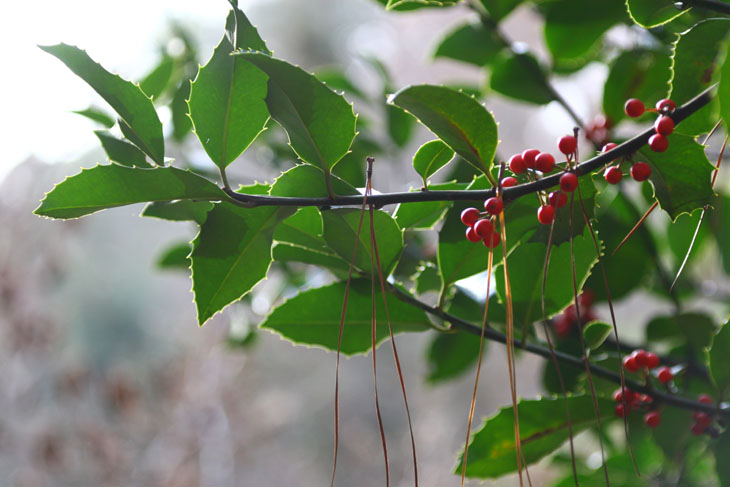
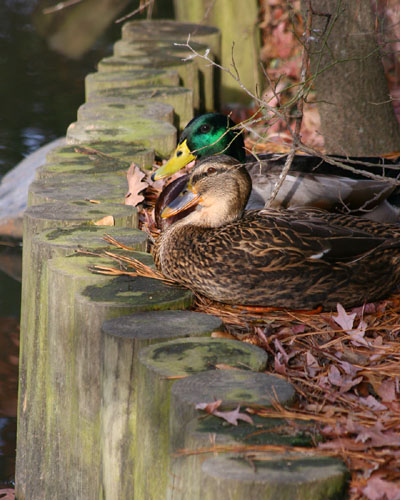 On to the ducks. Yeah, I know, mallards (Anas platyrhynchos) are probably the most common duck in North America, so no remarkable skills here, but I liked the composition with the lighting, and this does show the sexual dimorphism that is common in bird species and very pronounced in many ducks – the female is in front, the male behind. The males typically have the bright, elaborate plumage to attract the attention of the females, who perform the selection of mates. The plumage is an indication of health, as well as simply standing out – even we, a completely unrelated species, can spot an unhealthy bird from a short distance. More interesting is how the colors work, since they only appear this bright in direct sunlight, having a certain refractive quality to the feathers (also note the pintail at the top of the post.) In diffuse light to shade, however, the colors almost vanish, becoming so muted they only garner a tiny percentage of the attention, allowing the birds to roost in the shade safely without sending out much of a signal to predators. As is hinted at in the image, this pair were nestled in under a tree, and only the angle of the late afternoon sun threw this bright light upon them; the same conditions (in almost the exact same location) can be seen in this wood duck photo.
On to the ducks. Yeah, I know, mallards (Anas platyrhynchos) are probably the most common duck in North America, so no remarkable skills here, but I liked the composition with the lighting, and this does show the sexual dimorphism that is common in bird species and very pronounced in many ducks – the female is in front, the male behind. The males typically have the bright, elaborate plumage to attract the attention of the females, who perform the selection of mates. The plumage is an indication of health, as well as simply standing out – even we, a completely unrelated species, can spot an unhealthy bird from a short distance. More interesting is how the colors work, since they only appear this bright in direct sunlight, having a certain refractive quality to the feathers (also note the pintail at the top of the post.) In diffuse light to shade, however, the colors almost vanish, becoming so muted they only garner a tiny percentage of the attention, allowing the birds to roost in the shade safely without sending out much of a signal to predators. As is hinted at in the image, this pair were nestled in under a tree, and only the angle of the late afternoon sun threw this bright light upon them; the same conditions (in almost the exact same location) can be seen in this wood duck photo.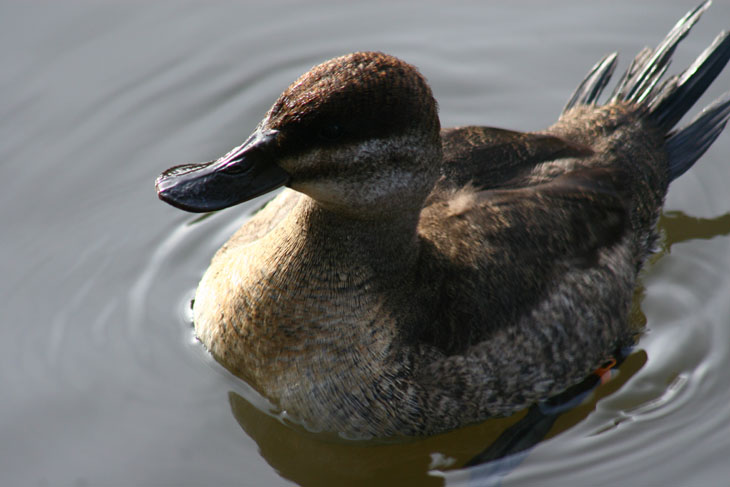
 Just an experiment in the bamboo grove, using a 19mm focal length, f8 with focus about 2 meters, and setting the camera on the ground aiming up, so taken blind. Out of several attempts, I like this composition best. Moreover, it shows no visible evidence of the graffiti that adorns most of the stalks, because the garden is frequented by college students who, on the whole, have not grown the fuck up yet. There’s not much you can do to bamboo when trying to carve your initials into the trunks, except produce a weak discoloration, but this is apparently enough for those who are desperate to leave their mark but lacking in any talent whatsoever – not everyone can be a pop star (really got the Old Man Thing going today, haven’t I?) I think next time I’ll go with at least f16 and a shorter focus, since it would be better to have the bottoms of the stalks in focus; the tops going out of focus would likely enhance the height aspect. Should’ve experimented more.
Just an experiment in the bamboo grove, using a 19mm focal length, f8 with focus about 2 meters, and setting the camera on the ground aiming up, so taken blind. Out of several attempts, I like this composition best. Moreover, it shows no visible evidence of the graffiti that adorns most of the stalks, because the garden is frequented by college students who, on the whole, have not grown the fuck up yet. There’s not much you can do to bamboo when trying to carve your initials into the trunks, except produce a weak discoloration, but this is apparently enough for those who are desperate to leave their mark but lacking in any talent whatsoever – not everyone can be a pop star (really got the Old Man Thing going today, haven’t I?) I think next time I’ll go with at least f16 and a shorter focus, since it would be better to have the bottoms of the stalks in focus; the tops going out of focus would likely enhance the height aspect. Should’ve experimented more.
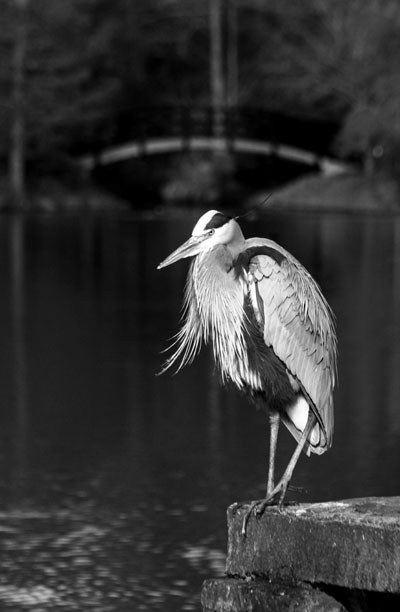 There is a resident great blue heron (Ardea herodias) at the gardens, quite possibly the same one I’ve photographed numerous times before, and it is remarkably mellow around the visitors. Great blues are variable species in this regard, since in most areas you’re likely to have a very hard time getting within fifty meters or so, but if they’ve become accustomed to human presence (usually through the prospect of easy food,) they might allow very close approaches. This image doesn’t present scale too well – they can stand well over a meter in height when fully erect, with a wingspan over two meters, and that beak is close to the length of your hand. Given the light conditions, I had to convert this one to greyscale, but did so with a technique I’ve posted about earlier, that of channel clipping. In this case, I removed the red and blue channels of the image, leaving only the green, then converted that to greyscale and increased contrast a little. The bridge in the background, which I had purposefully positioned myself to place there in the frame (since the heron, cooperative as it was, wasn’t taking instructions,) is actually bright red, but this went nearly black in the green channel. Had I used the red channel instead, the bridge would have become almost white and the foliage darker; I liked this one better. The blue channel is worthless more times than not for channel clipping, at least with the cameras I’ve used, but it does depend on what the image is of.
There is a resident great blue heron (Ardea herodias) at the gardens, quite possibly the same one I’ve photographed numerous times before, and it is remarkably mellow around the visitors. Great blues are variable species in this regard, since in most areas you’re likely to have a very hard time getting within fifty meters or so, but if they’ve become accustomed to human presence (usually through the prospect of easy food,) they might allow very close approaches. This image doesn’t present scale too well – they can stand well over a meter in height when fully erect, with a wingspan over two meters, and that beak is close to the length of your hand. Given the light conditions, I had to convert this one to greyscale, but did so with a technique I’ve posted about earlier, that of channel clipping. In this case, I removed the red and blue channels of the image, leaving only the green, then converted that to greyscale and increased contrast a little. The bridge in the background, which I had purposefully positioned myself to place there in the frame (since the heron, cooperative as it was, wasn’t taking instructions,) is actually bright red, but this went nearly black in the green channel. Had I used the red channel instead, the bridge would have become almost white and the foliage darker; I liked this one better. The blue channel is worthless more times than not for channel clipping, at least with the cameras I’ve used, but it does depend on what the image is of.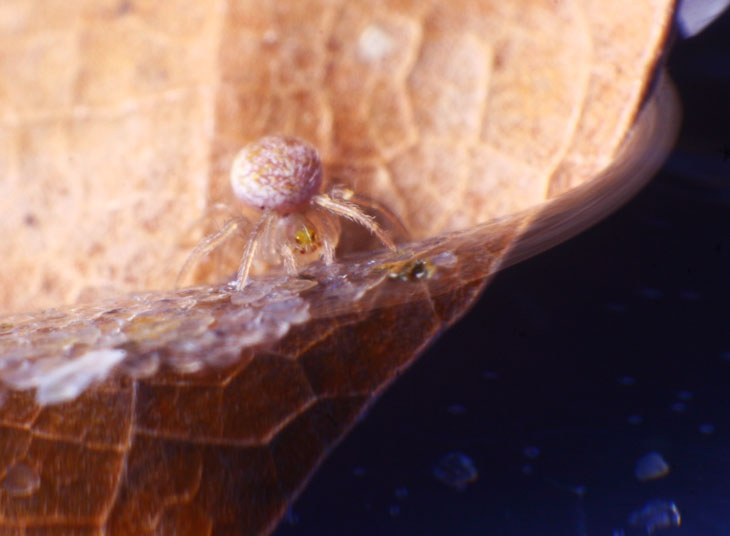




















































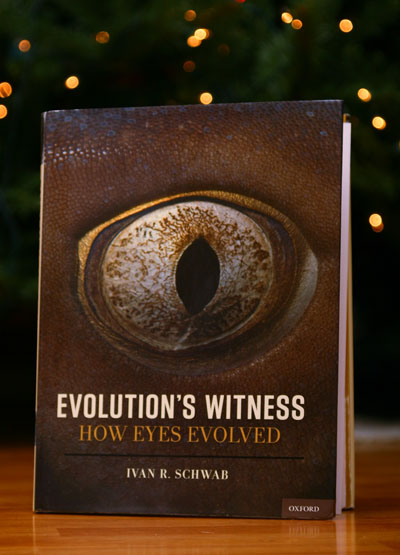
 That’s enough links to make you think I’m alternating font colors for the post, so let’s see if I can manage to avoid any more. The easiest way is by not writing much beyond this, so I’ll leave you with an appropriate image from a few days back, as one of the cats peered out from beneath the tree through a gap in the branches. This was their first christmas tree, and they were very well behaved with it though, granted, we did not put any ornaments within easy reach. They appeared to enjoy the day as well, since they had plenty of wrapping-paper balls to slap across the floor, and a Nerf-like gun shooting fascinating darts for them to chase (yes, it was my gift, and yes, I’m 49 years old – what’s your point? You got something to say?)
That’s enough links to make you think I’m alternating font colors for the post, so let’s see if I can manage to avoid any more. The easiest way is by not writing much beyond this, so I’ll leave you with an appropriate image from a few days back, as one of the cats peered out from beneath the tree through a gap in the branches. This was their first christmas tree, and they were very well behaved with it though, granted, we did not put any ornaments within easy reach. They appeared to enjoy the day as well, since they had plenty of wrapping-paper balls to slap across the floor, and a Nerf-like gun shooting fascinating darts for them to chase (yes, it was my gift, and yes, I’m 49 years old – what’s your point? You got something to say?)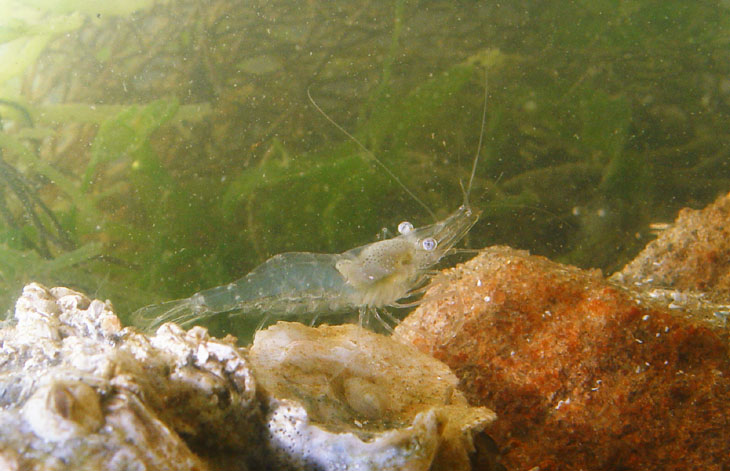
 What I had was eventually determined to be a
What I had was eventually determined to be a 
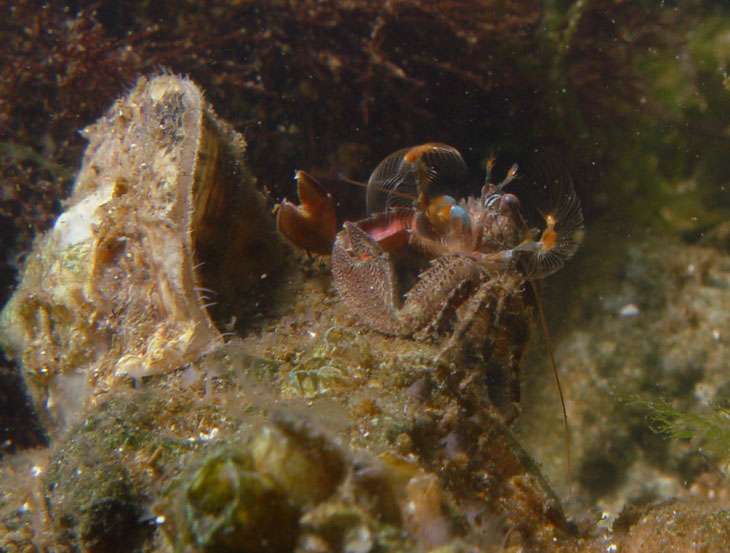

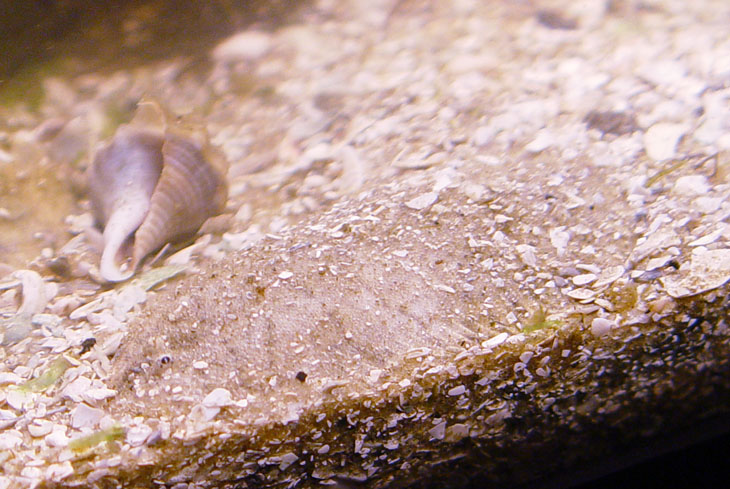
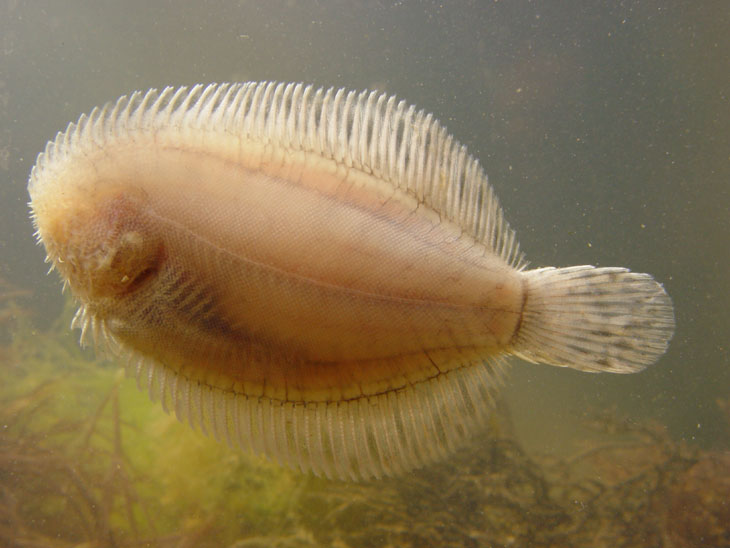
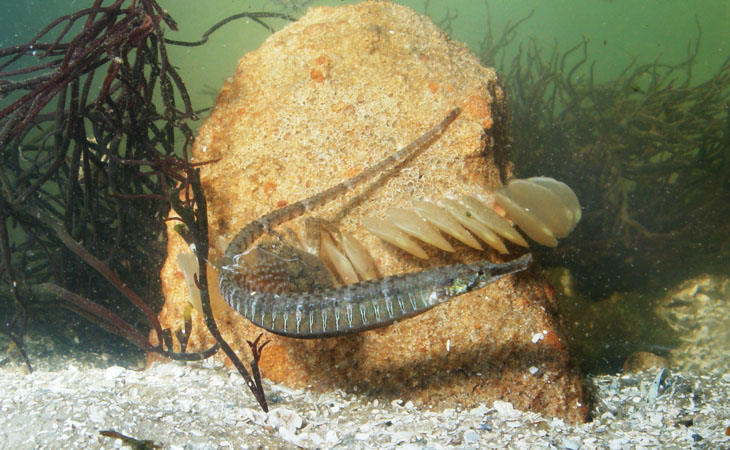
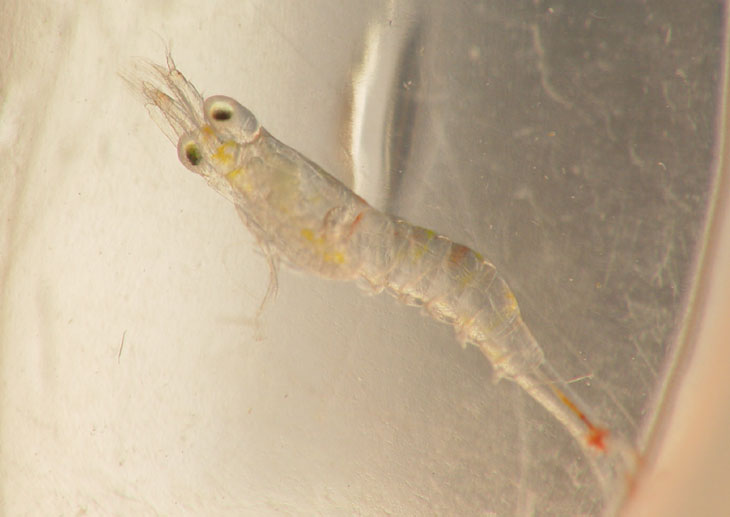
 The red rock with the snail’s eggs, seen behind the pipefish above, was a notably bare exception (though it appears in a ridiculous number of my images,) since most of the rocks I had in the aquarium were ‘living’ rock – in other words, bearing living matter thereon. I was startled to see one of the stones I collected, early on in the tank’s history, sprout a garden of little anemones soon after putting it in the water; it had spent the short trip back from the lagoon on the floor of the car out of water, because I hadn’t realized it was occupied. The anemones retract protectively when threatened and become
The red rock with the snail’s eggs, seen behind the pipefish above, was a notably bare exception (though it appears in a ridiculous number of my images,) since most of the rocks I had in the aquarium were ‘living’ rock – in other words, bearing living matter thereon. I was startled to see one of the stones I collected, early on in the tank’s history, sprout a garden of little anemones soon after putting it in the water; it had spent the short trip back from the lagoon on the floor of the car out of water, because I hadn’t realized it was occupied. The anemones retract protectively when threatened and become 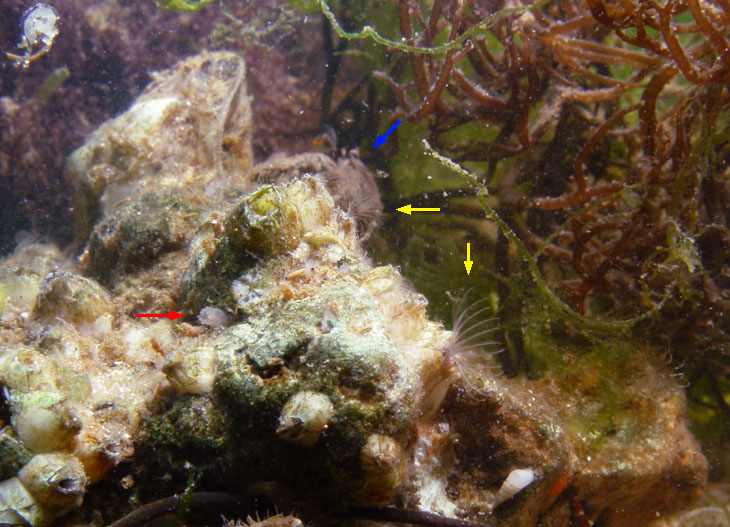


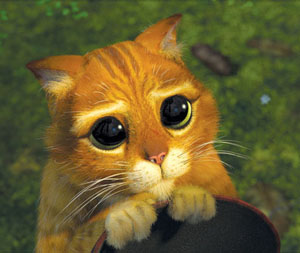
 Last year, I was making it a point to post more than I had any year earlier, and did indeed reach that mark, just a few days past this date last year. It is safe to say that I won’t be setting any records this year, since with this one I am 44 posts away, and I don’t see me knocking out, like, three posts a day from here on.
Last year, I was making it a point to post more than I had any year earlier, and did indeed reach that mark, just a few days past this date last year. It is safe to say that I won’t be setting any records this year, since with this one I am 44 posts away, and I don’t see me knocking out, like, three posts a day from here on. But I can put up a couple of images between long-winded posts, like this oak-leaf hydrangea (Hydrangea quercifolia) found at the botanical garden. I don’t think I’ve ever seen one in late fall, and I really like the effect – the leaves have a rich variety of colors, almost like those cheesy plastic fall decorations you can get at
But I can put up a couple of images between long-winded posts, like this oak-leaf hydrangea (Hydrangea quercifolia) found at the botanical garden. I don’t think I’ve ever seen one in late fall, and I really like the effect – the leaves have a rich variety of colors, almost like those cheesy plastic fall decorations you can get at 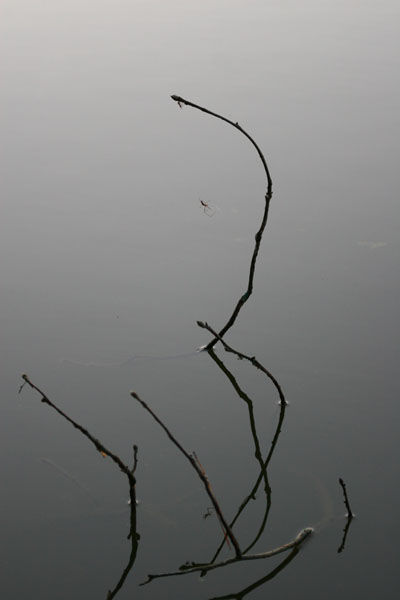 I’m continually impressed with the cold-weather hardiness of spiders. Last winter, I kept observing tiny
I’m continually impressed with the cold-weather hardiness of spiders. Last winter, I kept observing tiny 
 As my own example, I give you a warm christmas eve day, 2006, at the
As my own example, I give you a warm christmas eve day, 2006, at the 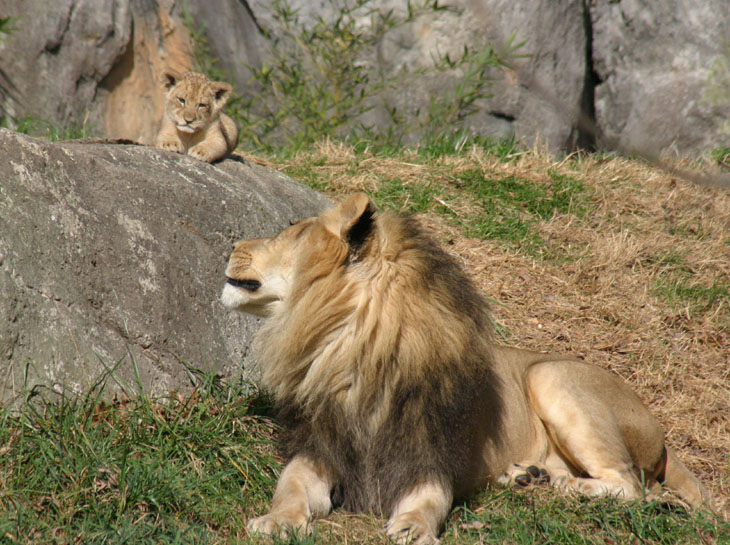


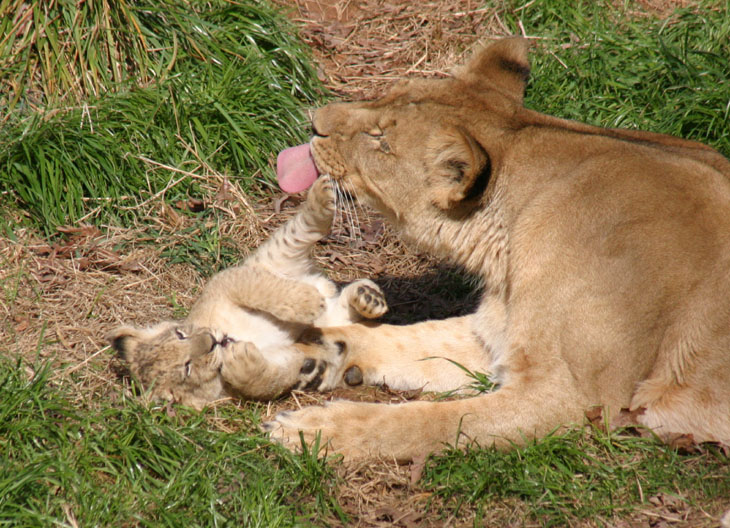

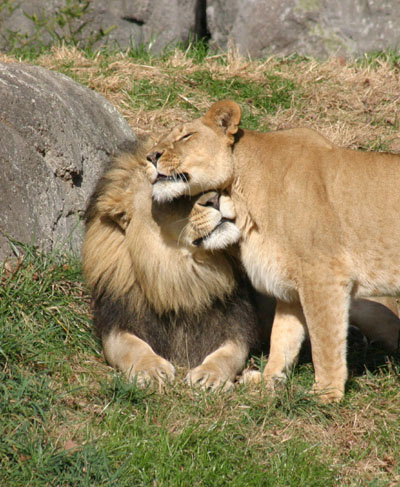 This is exactly what it appears to be – a very affectionate nuzzling, including some gentle nibbling on one another. I was there with The Girlfriend and The Younger Sprog, and you can imagine the reactions at this point, as well as the frantic instructions to, “Look! Look!” and, “Get it! Get it!” They could hear the shutter snapping as well as I could, or at least they should have been able to, but it’s possible that normal sensory functions were somewhat overwhelmed at that point. They were, naturally, getting their own shots as all this was taking place.
This is exactly what it appears to be – a very affectionate nuzzling, including some gentle nibbling on one another. I was there with The Girlfriend and The Younger Sprog, and you can imagine the reactions at this point, as well as the frantic instructions to, “Look! Look!” and, “Get it! Get it!” They could hear the shutter snapping as well as I could, or at least they should have been able to, but it’s possible that normal sensory functions were somewhat overwhelmed at that point. They were, naturally, getting their own shots as all this was taking place.
 Among the many reasons why my photography, and thus my posting, has slowed down so much is the temperature, which like most of the rest of the country has dropped significantly. The triops tank on the porch, which was no longer showing any activity anyway, had formed several thin sheets of exploratory ice crystals extending down into the depths – cool enough (a ha ha) when viewed within the water, but much more distinct when removed. Yet the real reason I’m commenting is that, unless you’re a rare individual, you will have no problem seeing a face in this image, at the very least now that I’ve mentioned it.
Among the many reasons why my photography, and thus my posting, has slowed down so much is the temperature, which like most of the rest of the country has dropped significantly. The triops tank on the porch, which was no longer showing any activity anyway, had formed several thin sheets of exploratory ice crystals extending down into the depths – cool enough (a ha ha) when viewed within the water, but much more distinct when removed. Yet the real reason I’m commenting is that, unless you’re a rare individual, you will have no problem seeing a face in this image, at the very least now that I’ve mentioned it.